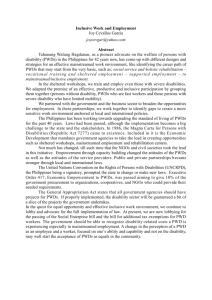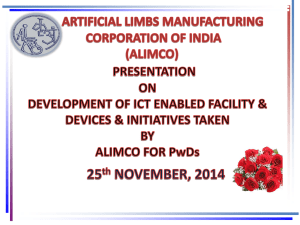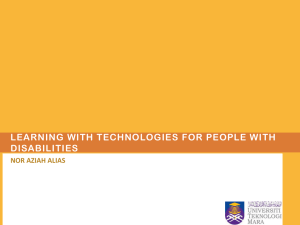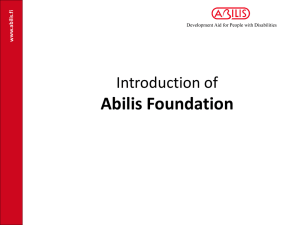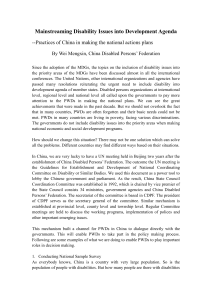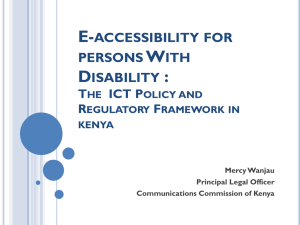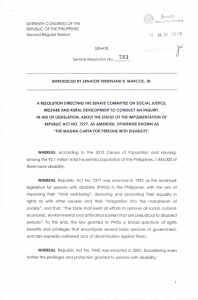Disability and Accessibility Rights
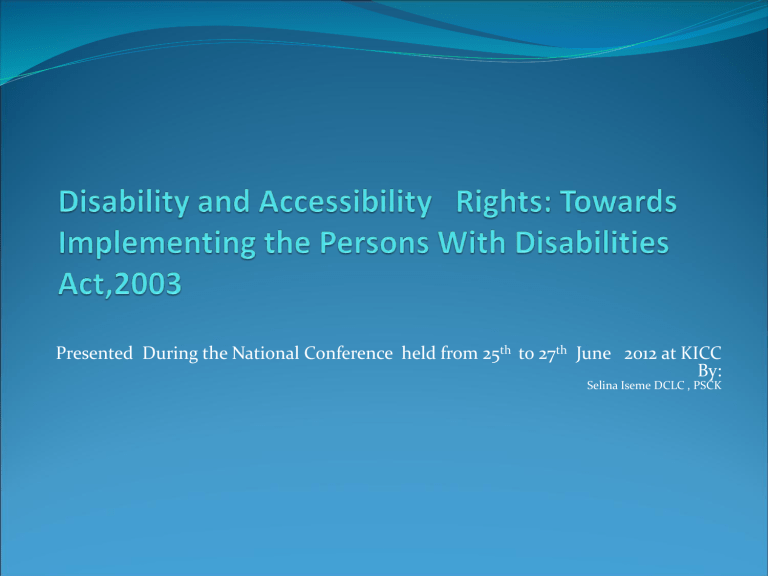
Presented During the National Conference held from 25 th to 27 th June 2012 at KICC
By:
Selina Iseme DCLC , PSCK
INTRODUCTION
The Public Service Commission is established under Article 233 of the Constitution.
The functions of the Commission are spelt out in
Article 234 of the Constitution and they includea) b) establishment of public offices; appointments and promotions; c) d) e) disciplinary control; promotion and reporting on the values in article
10 and 232 of the Constitution; hearing appeals with respect to county governments’ public service;
INTRODUCTION
cont…
f) g) h) i) human resource development; ensuring efficiency and effectiveness of the public service; determining conditions of service, qualifications and codes of conduct for public officers; determining the organization and administration of the public service; j) k) l) recommending persons to be appointed as principal secretaries by the President; receiving petitions for intended removal of the Director of
Public Prosecutions; making relevant nominations as prescribed in law; and m) performing any other function conferred by national legislation.
ILO STANDARDS ON MAINSTREAMING DISABILITY AT THE
WORKPLACE
ILO guidelines on mainstreaming disability at the
Workplace require employers to ensure that PWDs obtain and remain in employment without any hindrance. This can be achieved through carrying out reasonable adjustment more specifically by –
ensuring that the mode of advertisement does not indirectly discriminate against PWDs;
allowing PWDs the use of support devices and assistive services during the interview;
ILO STANDARDS ON MAINSTREAMING DISABILITY AT THE
WORKPLACE .
providing employees with disabilities equal for development ;
providing employees with disability adapted equipment, replacing steps with ramps or ensuring walkways are wide enough for wheelchairs;
allowing flexible work schedules to suit the needs of the employee with disability;
ILO STANDARDS ON MAINSTREAMING DISABILITY AT THE
WORKPLACE
rehabilitating and habilitating an employee who acquires disability while already employed the and putting in place return to work programme; and
if the employee is not in a position to resume the previous employment then employee shall be deployed to perform duties that match his /her residual potential and skills.
POLICY DIRECTION TAKEN BY PSC TOWARDS IMPLEMENTING THE
PERSONS WITH DISABILITIES ACT.
PSC issued a Code of Practice On Mainstreaming
Disability in the year 2010. The objectives of the
Code are to -
ensure that PWDs have equal opportunities in the public service;
improve employment prospects in the public service for PWDs by facilitating recruitment, return to work, job retention and opportunities for advancement;
promote a safe, accessible and healthy workplace conducive to the needs of PWDs;
OBJECTIVES OF THE CODE cont…
maximize the contributions which public officers with disabilities can make to the Government;
facilitate PWDs including learners with special educational needs to access the workplace in the public service for the purpose of internship and attachment; and
assure that the needs of PWDs are catered for in the discharge of human resource functions and management in the public service.
HIGHLIGHTS OF THE PSC CODE ON MAINSTREAMING
DISABILITY
Recruitment‐public entities shall recruit job seekers with disabilities including those who have not worked before and those who need to return to work after a period of non‐employment ;
Interviewing and testing-
Selection tests should be in a format that is accessible to PWDs.
candidates with disabilities should be permitted to use of assistive and support devices and assistive services like sign language interpreter or Braille, presence of personal aide or service animal during interviews.
HIGHLIGHTS OF THE CODE cont…
Where a public officer acquires disability while in employment the need to ensurei.
early intervention, referral to appropriate services and rehabilitation; ii.
iii.
iv.
measures for a gradual resumption of work are put in place; opportunities for the officer to test work or obtain experience in an alternative job if the officer is unable to resume the previous job; use of support and technical advice to identify any opportunities and adjustments which might be required;
HIGHLIGHTS OF THE CODE cont… v.
vi.
vii.
mitigating measures are put in place so as not to exacerbate the existing condition of the officer; identification necessary training or re‐training for the officer; reasonable modifications or adaptations of the job, work station or work environment; viii.
the provision of assistive or support devices and assistive services for the officer;
HIGHLIGHTS OF THE CODE cont… viii.
the provision of assistive or support devices and assistive services for the officer; ix.
the need to consult an officer before redeployment on account of disability; the officers occupational preferences should be taken into account in decision making; and x.
in the event an officer acquires disability while in employment taking measures aimed at utilizing the residual potential and skills of the officer before considering to take any other steps;
ADMINISTRATIVE STEPS TAKEN TOWARDS IMPLEMENTING THE
ACT
Whenever a vacancy is advertised the Commission-
advertises the vacancies in the print media and the
Commission’s website;
places radio alerts informing the public of the advertisement of posts;
Further the commission
maintains data regarding PWDs recruited to ensure progressive achievement of the 5% constitutional requirement;
has customized four washrooms to meet the needs of PWDs.
ADMINISTRATIVE STEPS TAKEN TOWARDS IMPLEMENTING THE
ACT cont…
has ensured availability of an interview board room on the ground floor to ensure that candidates who by reason of disability is not able to access other floors do not miss out on interviews(The structural make up of Commission house cannot allow construction of a ramp to the
4 th floor);
upon request approves extension of service of officers with disabilities as long as there is a medical report confirming the nature of disability.
ADMINISTRATIVE STEPS TAKEN TOWARDS IMPLEMENTING THE
ACT cont…
In addition to the measures outlined above the
Commission has advertised for consultancy services for a baseline survey on the state of the public service. One the parameters to be measured include the number of PWDs in the public service.
The findings of the survey will inform further steps to be taken.
GAPS AND CHALLENGES IN THE IMPLEMENTTATION OF THE ACT
Almost ten years since the passage of the Act accessibility both to public buildings and public service vehicles still remains a challenge.
The structural make up of some old buildings makes it impossible for ramps to be constructed to higher floors.
The most common form of public transport is low capacity vehicles(14 seater matatus) and because of the size it may not be possible for them to be customized to meet the needs of PWDs
GAPS AND CHALLENGES IN THE IMPLEMENTTATION OF THE ACT
Although it is easier to identify physical disability it is difficult to identify the other types of disabilities and as such many programmes towards mainstreaming disability may focus more on physical disability only and not the other types of disabilities.
PWDs rarely disclose information on disability in the application form .
Very few candidates apply for jobs advertised by
PSC and so it may take time before the 5% principle is realized.
POSSIBLE PUBLIC RESPONSE TO ADJUSTMENT ORDERS AND TAX
EXEMPTION
There is bound to be resistance from the owners of the buildings and PSVs on adjustment orders and high implementation costs will be cited as the reason.
It is likely that there will be litigation that may arise from the adjustment orders.
As for tax exemption this may not elicit as negative reactions as adjustment orders will.
STRATEGIES FOR IMPLEMENTING THE ACT
Ministry of housing should have in place a building Code that gives effect to the Act
Local authorities should not to approve any building plan unless the plan has taken into account access needs for PWDs
The Transport Licensing Board should not to license any PSV unless the same is customized to cater for the needs of PWDs; the earlier government policy to phase out small capacity vehicles should be pursued.
STRATEGIES FOR IMPLEMENTING THE ACT
The learning institutions should afford PWDs opportunities to equip themselves with skills that will enable them access employment in order to achieve the 5% principle.
Government should ensure all buildings housing government offices are responsive to the needs of persons with disabilities.
Alternatives should be provided relating to buildings whose structural make up will not accommodate major adjustments.
intensive awareness creation on the requirement needs for PWDs should be carried out in to avert negative reactions that may follow adjustment orders.
STRATEGIES FOR IMPLEMENTING THE ACT
Government could issue a policy to the effect that for one to transact business with government their businesses must be compliant to the Act so that before a contract is awarded the supplier must be evaluated on compliance with the Act.
intensive awareness creation on the requirement needs for PWDs should be carried out in to avert negative reactions that may follow adjustment orders.
MONITORING IMPLEMENTATION OF THE ACT
Institutions that are key in the implementation of the
Act are represented in the Council. These institutions are able to enforce the Act though exercise of their powers to grant approvals or licenses. In the performance of these duties the institutions should have in built monitoring mechanisms which they can use as a basis of preparation of reports on compliance.
Institutions charged with recruitment in the public service should also have in built mechanisms to monitor the realization of the 5% principle and every year there should be a report on the percentage representation of PWDs in the public service.
CONCLUSION
The composition of the NCPWD is such that it is possible for the objectives of the Act to be achieved if deliberate measures are put in place.
The access should not be limited to physical access only but should include access to information and opportunities.
The private sector is key in ensuring the Act is implemented and rewards and sanctions can be used to rope in the private sector.
Thank you
